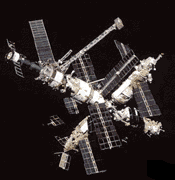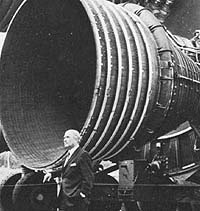|

The USSR launched space-stations of gradually increasing size, the Soyuz, Salyut and (in 1986) the Mir space station (on right). Over the years Mir was extended by additional modules (one of which was damaged by an accidental collision in 1997) and was still operating in 2000. It finally re-entered the atmosphere on 23 March 2001, near the Fiji islands in the Pacific Ocean. Its re-entry was observed from the ground and fragments which did not burn up splashed harmlessly into the ocean. Construction of the International Space Station began in November 1998 with the placing in orbit of the Russian module "Zarya", followed in December by NASA's "Unity." As of the end of 2000, a US-Russian crew is stationed aboard it. Reentry
Any manned mission faces the problem of safe return to Earth, which requires getting rid of the huge amount of energy associated with orbital motion. A spacecraft in low Earth orbit moves at about 24 times the velocity of sound. Since the energy of motion ("kinetic energy") is proportional to the square of the velocity v, gram for gram (or ounce for ounce) such a spacecraft carries 242 = 576 times more energy than an object moving at the velocity of sound (in air), e.g. a typical pistol bullet. Atmospheric friction converts this energy into heat, enough heat than to melt or even evaporate the re-entering material, even if it is a tough metal. To get rid of this heat, the vehicle re-enters the atmosphere at a shallow angle, stretching out the time spent in the more rarefied upper layers. It is also useful to present a blunt obstacle to the air, creating a strong shock front well ahead of the reentry vehicle, which dissipates much of the heat. For this reason the space shuttle starts re-entering the atmosphere bottom-first, and only after almost all its velocity is lost does it turn around to the nose-first attitude of an airplane. 
Still, a great amount of heat reaches the spacecraft, requiring its forward-facing part to be lined with heat-resistant material. Mercury, Gemini and Apollo used shields which gradually wore down (ablated), sparing the spacecraft which then landed by parachute. The shuttle's bottom was lined with lightweight heat-resistant tiles of a special material. The Soviet Union built and in 1988 flew its own space shuttle, the Buran, but though its tests were successful, it was not used afterwards.
Unmanned SpacecraftSo great is the variety of unmanned spacecraft that even more than manned spaceflight, it is impossible to cover all of them here. The sites below date back to 2002-4, when they were first incorporated in "From Stargazers to Starships." While expanded, do NOT cover later years in comparable detail; many sites originally listed are gone, and were replaced by links to Wikipedia. Unmanned scpacraft can be divided into five groups, described separately in files linked to the list below:
The "Falcon 9" Launch RocketElon Musk, a visionary engineer, set out to build a new reliable low-cost rocket launcher. He founded the Space-X corporation which developed, stage by stage, the Merlin rocket engine, the Falcon rocket using it and later the 300+ ton Falcon 9 rocket which used a cluster of 9 Merlins. Falcon 9 was successfully launched into orbit on June 4, 2010, and a second launch was carried out late on December 7, 2010 and included the "Dragon" upper stage, which returned to Earth behind a protecting heat shield in the morning hours of December 8. Details of later flights by "Falcon 9" will not be covered here, except to note that it was also the rocket which successfully pioneered the retrieval of first-stage rockets after launch. Exploring Further:A book on Yuri Gagarin: "Starman: The Truth Behind the Legend of Yuri Gagarin" by Jean Doran and Piers Bizony, Bloomsbury (Great Britain) 1998. Questions from Users: Is a heat shield needed while going up? Also: *** Why is the path of reentry from space so critical?. *** Spacecraft Attitude *** Re-entry from orbit *** Sticking a hand out of a window... *** Shuttle re-entry from space (a) *** Shuttle re-entry from space (b) *** How do Rockets Land? *** Shape of nose of rocket |
Next Stop after the ones cited above: #30 Far-out Pathways to Space: Great Guns?
Timeline Glossary Back to the Master List
Author and Curator: Dr. David P. Stern
Mail to Dr.Stern: stargaze("at" symbol)phy6.org .
Updated 12-8-2010 and again 22 October 2016